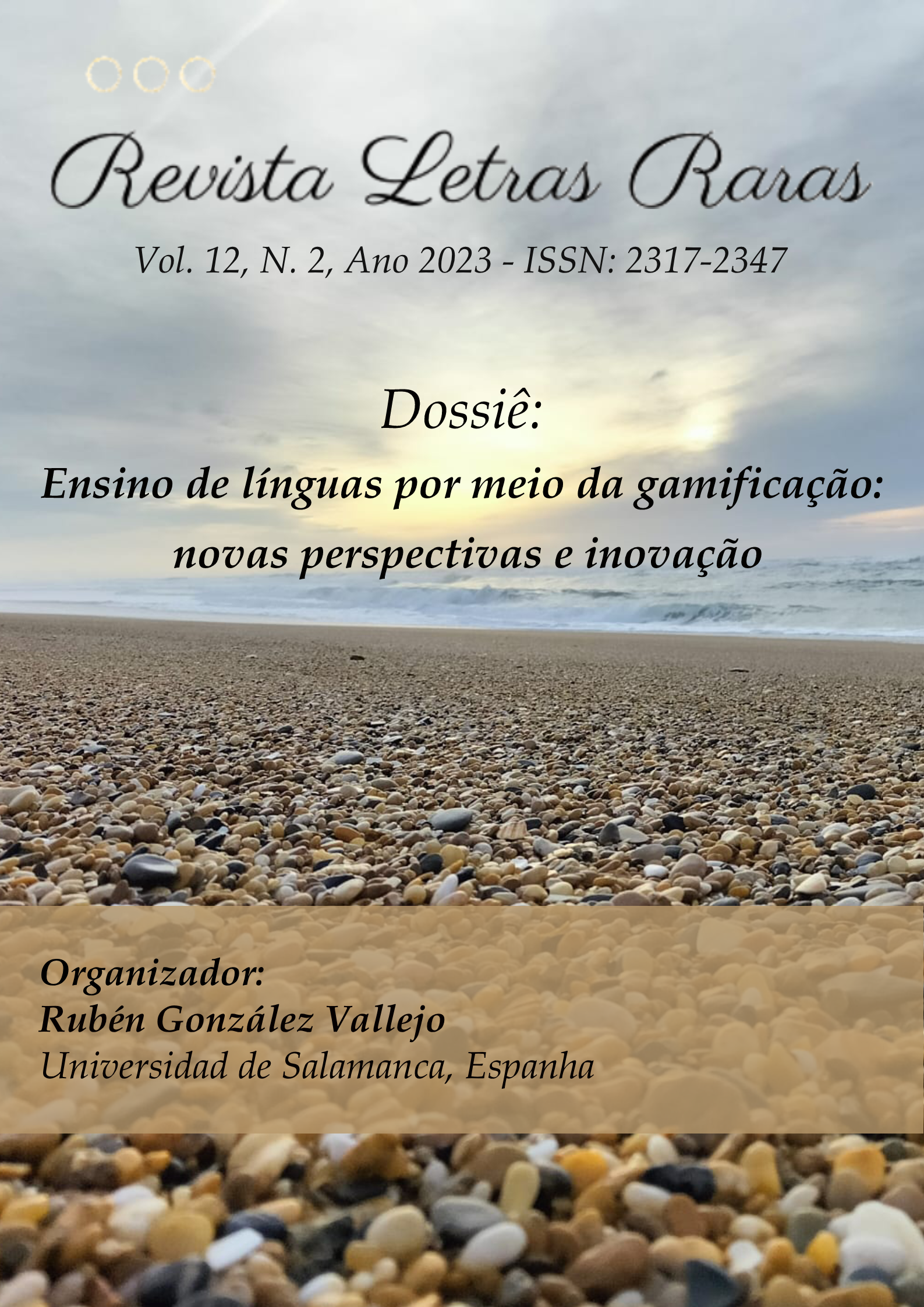La gamificación con videojuegos en clase de ELE: propuesta didáctica
DOI:
https://doi.org/10.5281/zenodo.8299775Keywords:
Gamificación, Videojuegos, Español lengua extranjera, Propuesta didáctica, Librojuego digitalAbstract
The world of language teaching and acquisition, just like any other sector of society, is currently going through an adaptation process due to the appearance of the Internet and new technologies. The first goal of this article is to study the possibilities within a Spanish language class of one of the most emblematic objects of technological development: videogames. To achieve this, we will first examine the theoretical framework in which the concepts ‘game’, ‘serious game’, ‘videogame’ and ‘gamification’ are analyzed and later present examples of videogames that are being used increasingly often in the classroom. The second objective, which concludes the article, is the elaboration of a gamified educational proposal consistent with the creation of an in-class digital gamebook using user-friendly and easy access software.
Downloads
References
AARSETH, E. Investigación sobre juegos: aproximaciones metodológicas al análisis de juegos. Artnodes. 2007. Disponible en: https://dialnet.unirioja.es/servlet/articulo?codigo=2576394. Acesso el 23 de Julio de 2021.
ABELA, J. The Gamified Classroom (Kindle ed.). Autopublicado. 2020.
ABT, C. Serious Games. Lanham: University Press of America. 1987.
AEVI: Asociación Española de Videojuegos. LA INDUSTRIA DEL VIDEOJUEGO EN ESPAÑA: Anuario 2020. 2020. Disponible en: http://www.aevi.org.es/web/wpcontent/uploads/2021/04/AEVI_Anuario_2020.pdf. Acceso el 19 de Julio de 2021.
AJELLO, A. La motivación para aprender. En Manual de psicología de la educación. Madrid: Popular. 2003.
BELLI, S., & LÓPEZ REVENTÓS, C. Breve historia de los videojuegos. Athenea Digital. 2008, p. 159-179. Disponible en: https://www.redalyc.org/pdf/537/53701409.pdf. Acceso el 26 de Septiembre de 2021.
BUSHNELL, N. Pong. [Videojuego] 1972.
CORTÁZAR, J. La Rayuela. Buenos Aires: Phanteon Books. 1963.
DE HEIJ B., BOSMAN, S., HAGOORT, T., & WARMAN, P. The Global Games Market: : Key Facts & Insights On the Global Games Market 2012-2016. Newzoo. 2013. Disponible en: https://newzoo.com/wpcontent/uploads/2011/06/Newzoo_Free_Global_Trend_Report_2012_2016_V2.pdf. Acceso el 19 de Julio de 2021.
ESCRIBANO, F. Homo Alien: Videojuego y gamificación para el próximo hacking cognitivo. Sevilla: Héroes de Papel. 2020.
GAMERDIC. Definición aventura conversacional. 2013 Disponible en: https://www.gamerdic.es/termino/aventura-conversacional. Acceso el 4 de Agosto de 2023.
GIL JUÁREZ, A., & VIDA MOMBIELA, T. Los Videojuegos. Barcelona: Editorial UOC, 2007.
GROS SALVAT, B. La dimensión socioeducativa de los videojuegos. Revista Electrónica de Tecnología Educativa(12), 2000. Disponble en: https://www.edutec.es/revista/index.php/edutec-e/article/view/557/291. Acceso el 26 de Septiembre de 2021.
HERRERA , F., RAMÍREZ, M., ROA, J., & HERRERA, I. Tratamiento de las creencias motivacionales en contexto educativos pluriculturales. Revista Iberoamericana de Educación, 2, 2004. Disponible en: https://rieoei.org/RIE/article/view/2885/3818. Acceso el 24 de Julio de 2021.
HIGGINBOTHAM, W., & DVORAK, R. Tennis for Two, [Videojuego] 1958.
INSTITUTO CERVANTES. Exámenes DELE B2. Disponible en: https://examenes.cervantes.es/es/dele/examenes/b2. Acceso el 5 de Agosto de 2023.
KAPP, K. Another Proposed Definition of “Game”, 2011. Disponible en: https://karlkapp.com/a-proposed-definition-of-game-2/. Acceso el 26 de Septiembre de 2021.
KAPP, K. The gamification of learning and instruction: game-based methods and strategies for training and education. Pfeiffer, 2012.
KAPP, K. Two Types of #Gamification, 2013. Disponible en: https://karlkapp.com/two-types-of-gamification/. Acceso el 20 de Julio de 2021.
LEÓN JARIEGO, R., & LÓPEZ LÓPEZ, M. Los adolescentes y los videojuegos. Apuntes de Psicología, 2003.
MANIEGA LEGARDA, D., YÀNEZ VILANOVA, P., & LARA NAVARRA, P. Uso de un videojuego inmersivo online 3D para el aprendizaje del español: El caso de “Lost in La Mancha”. ICONO 14, 2011, p.101-121 Disponible en: https://icono14.net/ojs/index.php/icono14/article/view/50/36. Acceso el 22 de Julio de 2021.
MCGONIGAL, J. Reality is Broken: Why games make us better and how they can change the world. New York: The Penguin Press, 2011.
MICHAEL, D., & SANDE, C. Serious games: Games that educate, train, and Inform. Boston: Thomson Course Technology, 2006.
MOJANG. Minecraft Education Edition, 2021. Recuperado de https://education.minecraft.net/en-us/homepageMOJANG STUDIOS. Minecraft, [Videojuego], 2009.
MUSEUM OF PLAY. The Strong National Museum of Play: Videogame History Timeline. Disponible en: https://www.museumofplay.org/about/icheg/video-game-history/timeline. Acceso el 19 de Julio de 2021.
NEWZOO. Global Games Market Report: The VR & Metaverse Edition, 2021. Disponible en: https://newzoo.com/insights/trend-reports/newzoo-global-games-market-report-2021-free-version/. Acceso el 19 de Julio de 2021.
OXGORD UNIVERSITY PRESS. Gamification. Oxford Learner's Dictionary. Disponible en: https://www.oxfordlearnersdictionaries.com/definition/english/gamificationq=gamification. Acceso el 19 de Julio de 2021.
PACKARD, E., MONTGOMERY, R., & STRETCH, J. Choose your own adventure. Bantam Books, 1979.
PAREIRA NARANJO, M. Motivación: perspectivas teóricas y algunas consideraciones de su importancia en el ámbito educativo. Revista Educación, 2009, p. 163-170. Disponible en: https://www.redalyc.org/articulo.oa?id=44012058010. Acceso 26 de Julio de 2021.
ROGANTI, P. Gamification Semplice: Game design applicato in contesti non ludici (Edición Kindle ed.). auto-ed, 2014.
ROUSE, R. Game Design: Theory & Practise (Segunda ed.). Wordware Publishing, 2005.
RUSSELL, S. Spacewar! [Videojuego], 1962.
SHAFTO DOUGLAS, A. OXO [Videojuego], 1952.
VAN ROOIJ, A., J. FERGUSON, C., COLDER CARRAS, M., KARDEFELT-WINTHER, D., SHI, J., AARSETH, E., . . . K. PRZYBYLSKI, A. A weak scientific basis for gaming disorder: Let us err on the side of caution. Journal of Behavioral Addictions, 7(1), 1-9, 2018. Disponible en: https://doi.org/10.1556/2006.7.2018.19. el 27 de Septiembre de 2021.
VERSVIK, M., BRAND, J., & BROOKER, J. Kahoot, 2012. Disponible en https://kahoot.com/WORLD HEALTH ORGANIZATION. Gaming Disorder. ICD-11, 2023. Disponible en: https://icd.who.int/browse11/l-m/en#/http://id.who.int/icd/entity/1448597234. Acceso el 4 de Agosto de 2023.
Downloads
Published
How to Cite
Issue
Section
License
Copyright (c) 2023 Revista Letras Raras

This work is licensed under a Creative Commons Attribution-NonCommercial 4.0 International License.







